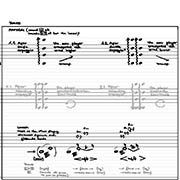After the milestone of his opera “South Pole” for Munich, Miroslav Srnka is in demand as never before. A major portrait at the “Dialogues” Festival in Salzburg followed the première of his string quartet “future family”. New orchestral and music theatre compositions are on the horizon.
1. At the “Dialogues Salzburg” Festival recently, there was a veritable retrospective of important compositions, combined with other interesting events around your music. What made this programme special – also with regard to communicating with the audiences?
For me it was the special attention given to dramaturgy. Although it is a short four-day festival, over a period of 18 months each programme has been very precisely gauged. The festival confronts contemporary music with classical repertoire. That is always dangerous, for it is often simply stuck together in a kind of sandwich structure. But not here. It was very exciting searching for deep connections, such as between the string quartets of Janáček and my Engrams and the piano quintet Pouhou vlnou. In this concert I myself realised afresh how much I have learnt from this genius. Over the course of the festival you could see how contact with the audience developed. For example, through an improvisation concert by Mahan Esfahani, a scientific cabaret on the theme of cold and ice, a serious-comic song recital, podium discussions with people who have experienced actual extreme situations in nature or between people – which then often become abstract artist themes, etc. …
It was then surprising how a different audience came to the final concert with Mozart’s Requiem, and this connection then had to be newly established. In fact we wanted to open the building completely, a kind of exhibition of music in a concert building you could freely wander through, a kind of line-up of pieces in an open space where you could move around the whole afternoon and evening. But there were also practical restrictions such as ticket sales and planning security for the public, etc. In the end the Mozarteum was transformed from a well-known historic concert hall to a more abstract indoor-outdoor space simply through its white floors and a luminous wall. I think that a feeling of freedom for the audience is the most important precondition to successfully communicate demanding content and a perception of time in contemporary music.
2. The string quartet “future family” in Paris, Brussels and Heidelberg is the first important work after your major opera “South Pole” – a new approach to composing. It reveals a new technique of writing and new formal concepts. Do these point to the future?
In my experience something is always looking to the future if it is totally unclear at the beginning and there is a lot to discover. If, after a piece leaves questions and tasks remain open for the next work, these should point to the future direction. With future family I needed two days alone to explain all the playing techniques and ideas behind the piece to the Quatuor Diotima, although these are musicians I have worked extremely closely with for several years. We had several performances in different places, and it was astonishing how the timing and interaction changed. The reflexes and modes of response on the stage had to be newly developed too. It was fascinating for me to be able to observe this and to learn from it.
The quartet demands great trust between the musicians and the score. It is very open. The musicians choose their part in the piece – each part is intended to be performable on all instruments. I call them more “roles” or “musical characters”. As in a 21st century family, everyone should be able and free to shape his or her role individually, and not to have to conform to stereotypes. In this piece the choice is free too. In this respect the string quartet as an ensemble is closest to a family “musically and socially”.
I have also composed the entire score – which is dedicated to the husband and wife publishers Barbara and Leonhard Scheuch of Bärenreiter – quite differently from a technical point of view: it is at the same time digital and yet a manuscript. It is written with a digital pencil in a specially prepared graphic environment. A manuscript is created which, however, can be treated as a whole, like a graphic vector file.
Although for practical reasons the first concerts were performed from temporary printed-out parts, the aim is that the piece exists as an online manuscript where people can generate their own performing score according to the choice of roles. Some technical development is still needed.
When I had completed the file, my editor Michael Töpel, who has taken care of my scores at Bärenreiter for years, said: “These are the first hand-written notes I have ever seen by you.”
3. Your schedule contains an ensemble work for the Los Angeles Philharmonic’s concert series “Green umbrella” in November 2018, and in the longer term, also a new music theatre work. What is particularly important in this phase of conception, the choice of theme? Does it also involve a new adjustment in compositional techniques?
Tom Holloway and I are constantly in discussion about themes. We have had discussions electronically between Europe and Australia uninterrupted for almost 10 years. And in the process lots of themes have emerged. But most disappear again. But once every couple of months or years, something emerges which enthuses us repeatedly. We now have two topics at different phases of development on the table. Or rather, on our computer screens. Perhaps even a third.
The compositional techniques for these always have to be rooted in function and dramaturgy. In themselves they are empty. I am slowly realising that I always need a few years to make, so to speak, clusters of pieces which follow a common theme in different musical media. I think with future family the next such cluster has begun.
Interview by Marie Luise Maintz
(from [t]akte 1/2018)



